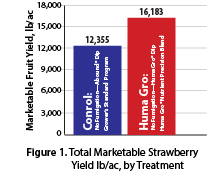 We lost Jason Garcia this week, his life cut short way too soon.
We lost Jason Garcia this week, his life cut short way too soon.
When Jason joined BHN as an agronomist in 2019, it was apparent early on that we had hired a special guy. Jason was ENTHUSIASTIC! Always. You just couldn’t have a conversation with Jason without hearing a great story about someone in his family, about a good friend or customer in Plant City, Fla., or about something special that had happened in a customer’s field.
Last year we put out an internal Employee Spotlight on Jason, which had this to say: [Read more…]

 OBJECTIVE
OBJECTIVE OBJECTIVE
OBJECTIVE In its May 2021 issue, Frontiers in Plant Science published a research article by BHN Humic R&D Lab scientists Dr. Hiarhi Monda, Ryan Fountain, and Dr. Richard T. Lamar in collaboration with Dr. Amy McKenna of the National High Magnetic Field Laboratory, Ion Cyclotron Resonance Facility, Tallahassee, Fla.
In its May 2021 issue, Frontiers in Plant Science published a research article by BHN Humic R&D Lab scientists Dr. Hiarhi Monda, Ryan Fountain, and Dr. Richard T. Lamar in collaboration with Dr. Amy McKenna of the National High Magnetic Field Laboratory, Ion Cyclotron Resonance Facility, Tallahassee, Fla. In this wide-ranging interview at BHN headquarters, BHN President & CEO Lyndon Smith and The Fertilizer Institute’s (TFI’s) President & CEO Corey Rosenbusch discuss TFI’s mission and vision, TFI member benefits, and challenges facing the fertilizer industry. Topics include TFI legislative and regulatory activities, the 4R Nutrient Stewardship initiative, the Responsible Ag program, new activities with the Biostimulant Coalition, the TFI Sustainability Committee, the TFI State of the Fertilizer Industry Report, and upcoming TFI conferences.
In this wide-ranging interview at BHN headquarters, BHN President & CEO Lyndon Smith and The Fertilizer Institute’s (TFI’s) President & CEO Corey Rosenbusch discuss TFI’s mission and vision, TFI member benefits, and challenges facing the fertilizer industry. Topics include TFI legislative and regulatory activities, the 4R Nutrient Stewardship initiative, the Responsible Ag program, new activities with the Biostimulant Coalition, the TFI Sustainability Committee, the TFI State of the Fertilizer Industry Report, and upcoming TFI conferences. Today on Episode 10 we’re talking about Growing Premium Potatoes with Huma Gro® Products. Our guests include Mr. Lyndon Smith, President and CEO of Bio Huma Netics, Inc.—the maker of
Today on Episode 10 we’re talking about Growing Premium Potatoes with Huma Gro® Products. Our guests include Mr. Lyndon Smith, President and CEO of Bio Huma Netics, Inc.—the maker of  When applied fertilizers benefit soil health and plant growth, and are readily available to them, it is said that they are bioavailable. The extent of bioavailability of nutrients and fertilizers applied to soil and plants determines their effectiveness in improving soil health and crop yield.
When applied fertilizers benefit soil health and plant growth, and are readily available to them, it is said that they are bioavailable. The extent of bioavailability of nutrients and fertilizers applied to soil and plants determines their effectiveness in improving soil health and crop yield. The best thing you can do to improve next year’s crop is to prep your soil before winter sets in. Your best tool for fall soil prep is Huma Gro® Fertil Humus®, which we’re offering at a 25% discount through the end of October .
The best thing you can do to improve next year’s crop is to prep your soil before winter sets in. Your best tool for fall soil prep is Huma Gro® Fertil Humus®, which we’re offering at a 25% discount through the end of October .